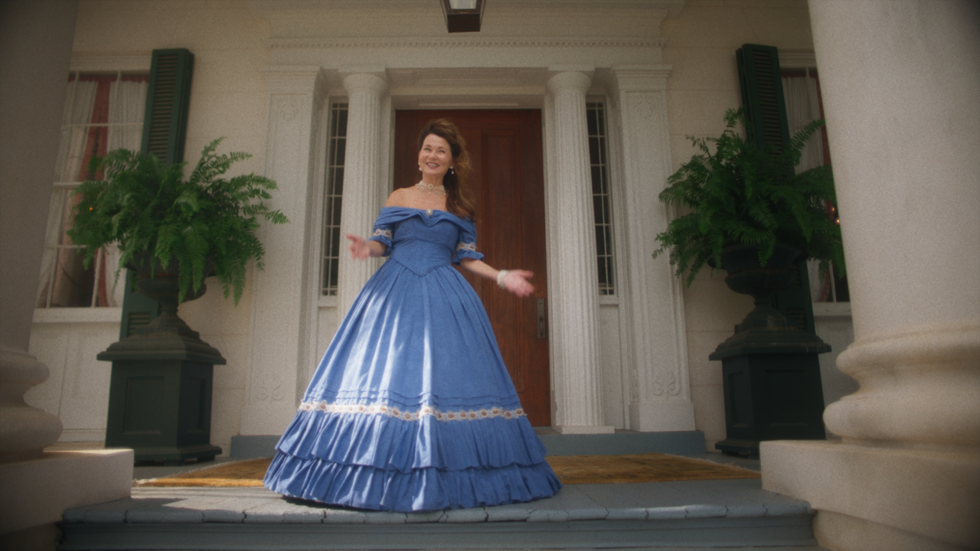Tribeca Film Festival 2025 Review: “Natchez”
By Morgan Roberts
Director: Suzannah Herbert
Runtime: 86 minutes
Year: 2025
“Behind the big house is the rest of the story.”
Natchez, Mississppi is a small Southern town rich with history. Its garden clubs have turned Natchez into a pilgrimage site tourists particularly interested in the American Antebellum era can visit. Homes dressed up like the first half of “Gone with the Wind,” homeowners in period-appropriate costumes, which until very recently included Confederate regalia. Despite the pomp and circumstance, the layered history of the region is in full view in Suzannah Herbert’s “Natchez,” as residents and tourists must choose to reckon with the painful past of this Mississippi town.
The documentary film begins dream-like, a “Stepford Wives” air wafts through these opening sequences. Yet, just as quickly as we are introduced to the idealized version of Natchez, the picture-perfect begins to crack, revealing its imperfect and harmful history. After we are introduced to the garden clubs and their rose-colored view of the Antebellum past, we begin to interrogate the accuracy and depth of that view with Rev. Tracy Collins is a local reverend and when he is not in the pulpit, he is giving tours to those visiting Natchez, providing them with the history of enslavement, Reconstruction, and white supremest systems of oppression which are still in place today. It is far from the glamour and grandeur of the big, beautiful homes, many of which house altered recollections of the histories they hold. For example, enslaved people are usually called “servants” by tour guides and home owners; the treatment of enslaved people are often equated to a great employer, with, hopefully, audiences knowing too well the inaccuracies in that.
If audience members are unsure of these inaccuracies, the film does a brilliant job of pairing those falsehoods with factual examinations of the history of Natchez. Whether it is Rev on his tour, garden club member Deborah Cosby sharing her home during the pilgrimages, the historical preservations championed by Ser Boxley, and the conservation and tours from park rangers Kathleen Bond and Barney Schoby, the film creates a tapestry of the truly complex history of Natchez. “Natchez” is able to expertly use some traditional documentary filmmaking techniques build out how the history of this town has been utilized as a means to cater to white discomfort. There are subtle confrontations throughout the film as many white residents attempt to perform impressive mental gymnastics to satisfy their need to play dress up in the Antebellum period without being associated with the harmful and many times evil history of that era.
Tracy McCartney in a still from “Natchez” | Tribeca Film Festival
One resident, Tracy McCartney, begins to confront her own understandings of this time period. When we meet Tracy, she is getting dolled up, wearing a hooped skirt dress, almost cosplaying Scarlett O’Hara, as she works at one of the Antebellum homes. We see how important her sense of belonging is; how this identity has given her meaning and community. And yet, she is willing to learn more about Natchez from outside of her original worldview and her openness to that journey is a stark contrast to others. Whether it is people at a party cherry-picking what to be concerned about or white tour guides at homes with their cognitive dissonance full on display. One guide in particular, David Garner, is the portrait of the most glaring inconsistencies. Garner, an openly gay man, holds incredibly racist views which he feels emboldened to share. Garner is a perfect example of how some in other marginalized groups will still align themselves to their whiteness to the detriment of others, including peers in their own community.
“Natchez” is a powerful film which investigates how one Southern town reconciles its painful history, whether some community members want to or not. Herbert sheds light on those in that region who fight for the realities of the Antebellum period are not forgotten, and how conservation and preservation truly confront our past. The film empowers its audience to explore how restorative justice can be a tool for confronting our history, healing what we can together, honoring the scars that are there, and learning how we can collectively move forward in these tumultuous times
Grade: A+
Pair This Film With: “Dahomey” (2024) dir. Mati Diop; “Harlan County U.S.A.” (1976) dir. Barbara Kopple; “The Order of the Myths” (2008) dir. Margaret Brown
